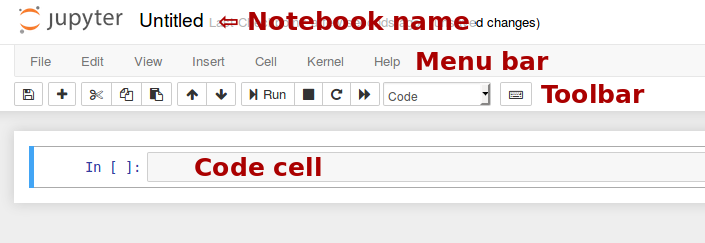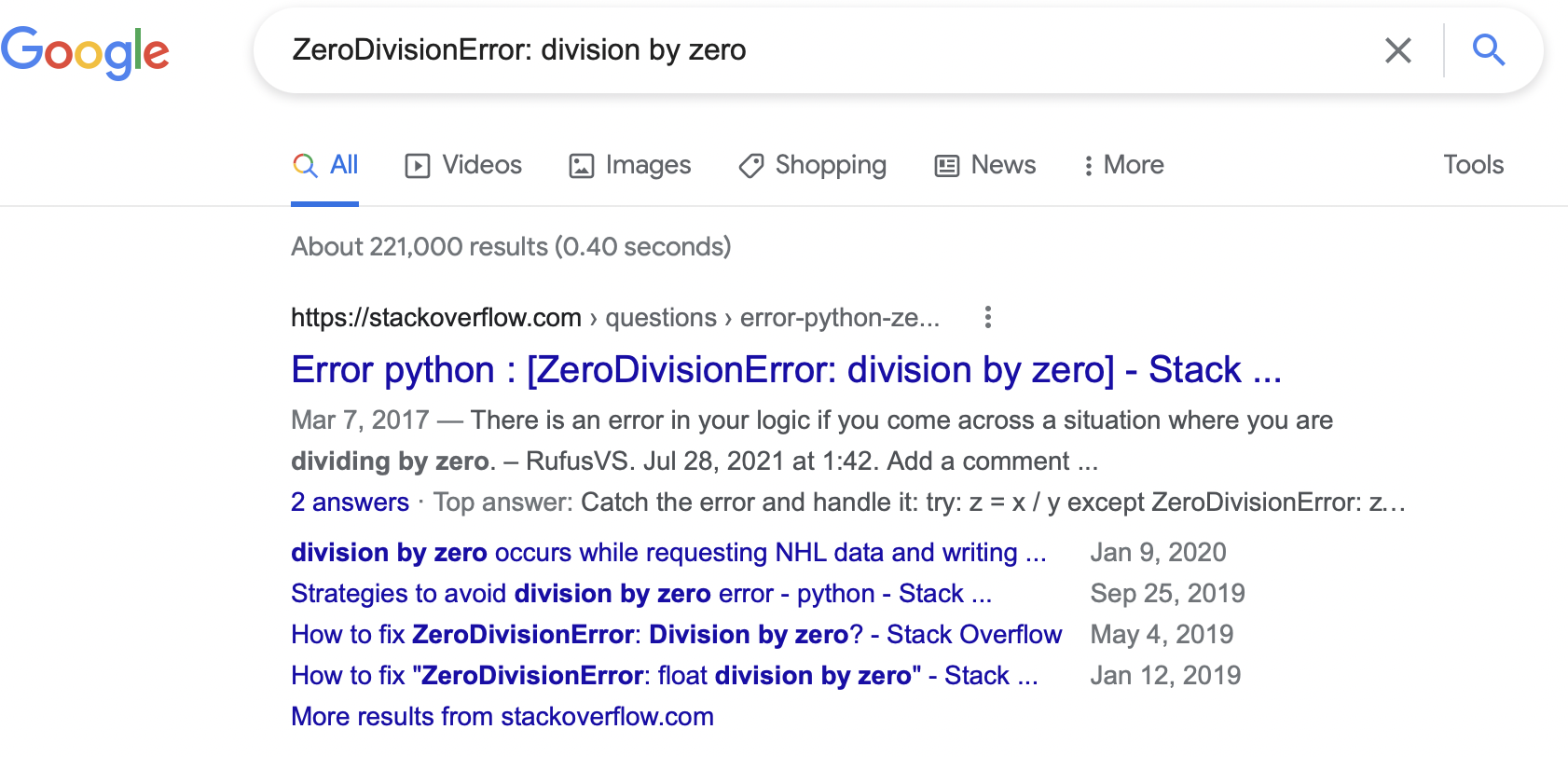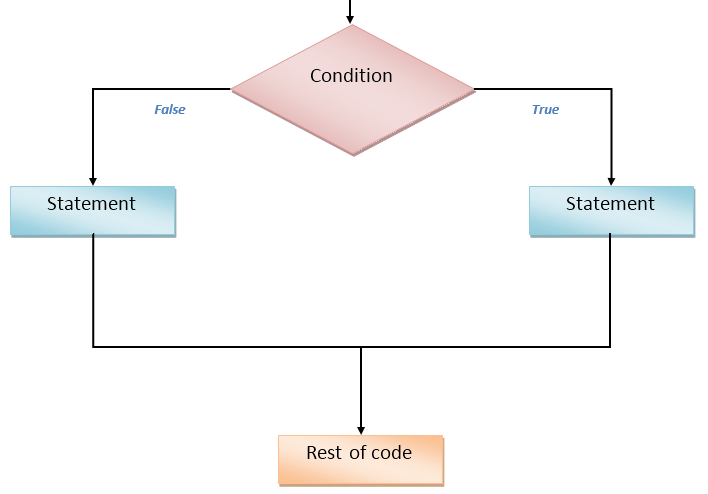Lecture 1: Python Basics
Contents
Lecture 1: Python Basics¶
Jupyter notebook is a tools to make your programming in an interactive way,
i.e., a cell-based environment where you can run your program in it one by one.
Compared to the original Python shell, it is more convinient to write, modify
and organize your code. In the remaining part of the lecture, I will
refer Python as Jupter notebook if it does not make confuse. So let’s go with it.
Note
You do not need to install Jupyter notebook because we have installed
Anaconda in the previous lecture and the latter one contains the former.
Here is a simple illustration of Jupyter notebook’s user interface.
As you can see, it is consise and easy to understand.

Fig. 11 Notebook name: You can change the notebook name here as you want. Code cell: A code cell is where you can write Python code. Once you have finished the code, press Shift+Eneter to run it.¶
Using Python as a calculator¶
It is good to treat Python as a calculator when use it for the first time. Try to type any equations in following box and run it!
1+2+3
6
Some common mathematical operators in Python are
+: addition,-: subtraction*: represents multiplication \(\times\)/: represents division \(\div\)//: represents integral division%: represents modulo operation**: exponential
Note
In mathematics, modulo operation returns the remainder. For example,
the results of 7%2 in Python is 1 because the remainder of \(7\div 2\) is \(1\).
1+2, 1-2, 2*3, 5/3, 5//3, 5%3, 2**10
(3, -1, 6, 1.6666666666666667, 1, 2, 1024)
Hint
What is the difference between / and //? Try by yourself!
7/2, 7//2
(3.5, 3)
Error Message When you run some illegal equations, e.g., \(1/0\) would lead to an error in Python.
1/0
---------------------------------------------------------------------------
ZeroDivisionError Traceback (most recent call last)
Input In [4], in <module>
----> 1 1/0
ZeroDivisionError: division by zero
Once you meet the message like this in your Python outputs, it means there can be something wrong with your code, and you’d better to check it again. For debugging, just copy the error message line and Google it!

Fig. 12 StackOverflow is a good place to find the solution to your issues.¶
Variable¶
Variable is something whose value can be changed. In Python, we use the combination of characters, digits, and underline(_) as variable name, except digits cannot occur in the beginning of the name.
Note
abc, ab2, _a, _2are all okay as a variable name.5G, @qq, ac.jpare not variable names.
In order to use a variable, you need to give it a value:
a = 2
If you try to use a variable without value, Python will complain with an error:
b
Some names are reserved by Python, so you cannot use them as variable name. These names are called keywords and listed as below
False True None and as assert break class continue
def del elif else except finally for from global if
import in is lambda nonlocal not or pass raise return
try while with yield
Note
Some modern editors such as Jupter notebook provide colorful theme and highlight keywords,
variable, etc. in your code, but do not rely on it too much. Check by your eyes!
Type: int and float¶
Each value in Python has its type, e.g., int represets an integer
and float represets a float number, which is similar to real number
in mathematics.
Basically, one value is automatically assigned with a specific type and
you can use type() to look up its type.
type(1), type(-2), type(1.0)
There can be some abbrevations for float number. For example, if there
is only one zero before/after the point, we can omit it.
.01, 1.
Scientific notation is a common numbering system for large numbers, and you can also use it in Python.
[a]e[b] is the standard form where [a] and [b] are integers and
this is equivalent to a float number \(a\times 10^b\).
type(1e-2)
Note
You can trust int because they are always accurate, while float are
not so much reliable because they are stored in computers in different
ways from int. In fact, float number will be formed into \(a\times 2^b\)
where \(a,b\) are integers. Following is a simple example to show you
how computers deal with numbers in a way different from mathematics.
a=1.1
b=2.2
a+b
Type: string¶
A string is some words quoted with quotation marks ' or ".
s = "hello world."
s
When the string contain quotation mark itself, try swith different
ones, e.g.,
s = '"python is good", he said'
s
or use escaped character \" to replace ":
s = "\"python is good\", he said"
s
For multiple-line string, use triple quoations like
"""
this is a multiple-line string
this is a multiple-line string
this is a multiple-line string
"""
Tip
A line of code begins with sharp symbol # is a comment in Python.
Python will not process any comment and it is only used to explain your code.
More interestingly, Python can naturally deal with Unicode symbol such as Chinese characters or Japanese Kana.
北海道大学 = "hokudai.ac.jp"
北海道大学
Cast between different types
Python provides int() to cast something to an integer:
int(1.5), int('1234')
and float() to cast something to a float number
float(1)
Boolean type¶
Boolean type has only two values: True and False.
You can directly assign boolean value to a variable, or it can
also be produced in boolean expression like
type(1==1)
Tip
More boolean expressions:
==: compare two numbers<=: less or equal \(\le\)>=: greater or equal \(\ge\)<: less>: greater!=: not equal
Python also provdes keyword not, which is calculated by
not True = False and not False = True.
Try these boolean expressions by yourself!
1<2, 1<=1, 3!=4
print() function¶
Here we introduce print() which is a useful for basic outputs.
It can outputs numbers,
print(1,2,3,4)
or string
print("hello", ", ", "world.")
Statement¶
Statement is something to control the computation in your program. In the previous section, all of our computation is single. However, in practice, we often want to do many computations by Python:
computation 1
computation 2
computation 3
...
Without statements, computation would be tedious and bored, and programming would be impossible. In this section, We will learn three important statements in Python.
Assignment statement¶
Assignment statements in Python is simple, with standard form
var = expression
where var is a variable name and expression could be numbers,
strings, boolean values and more complex calculation.
x = 1+2
boolean_var = True
text = "Python is good"
Note
More assignment operatoins:
var += expressionis equivalent tovar = var + expressionvar -= expressionis equivalent tovar = var - expressionvar *= expressionis equivalent tovar = var * expressionvar /= expressionis equivalent tovar = var / expression
Conditional statement¶

Fig. 13 A conditional statement usually has two branches. In each running,
Python will choose only one of them depending on if the condition
is True or False.¶
In Python, a standard form code corresponding to the above figure is like
if condition:
some statements
else:
some statements
However, sometimes we have only one branch to run, so
if condition:
some statements
is also okay.
Please notice the indentatoin (4 spaces here), otherwise, you code will be wrong.

Fig. 14 The red block represents a 4-space indentation. Please be careful with it.¶
Python use indentatoin to emphase code in different levels, which would help Python to recognize the code as a conditional statements. If there is no indentation in Python, the following code
if condition:
statement 1
statement 2
is confused for Python because it do not know the bound of branch.
Fore more branches, we can use keyword elif to extend if-else form:
if condition 1:
statement 1
elif condition 2:
statement 2:
...
(more branches)
...
else:
some statements
Note
Please try to write a GPA calculator with Python. The standard is shown as
\(4.0\) for score \(\ge 85\);
\(3.0\) for \(75\le\) score \(<85\);
\(2.0\) for \(60\le\) score \(<75\);
\(1.0\) for score \(<60\).
score = float(input("Input your score, and press 'Enter' key: "))
# write you code here
print("Your GPA is", gpa)
Loop statement¶
Loop is a simple way to deal with tedious work by Python. In a loop, the program would repeatedly do the samething until the loop ends.
In Python, there are two types of loop statements: while- and for-loop.
While loop¶
The standard form is
while condition expression:
some statements
Important
Please also notice the indentation here.
Here is a simple example to compute \(1+2+3+\ldots+100\), and by the formula
we know the answer is \(\frac{100\times(100+1)}{2}=5050\). So let Python check this!
i = 1
s = 0
while i<101:
s += i
i += 1
print(s)
Important
If your code does not give any responses as you expect, check
if there are any errors in the while-loop, e.g., can Python
ends the loop while reasonable iterations.
For loop¶
Although \(while\)-loop can help us to do anything we want. For loop is more convinient in some cases. It has a standard form shown as below
for element in collection:
some statements
Here collection is a special object in Python
from which we can pick up its elements one by one. In for-loop,
Python will pick each element in the order, and run the statements
and then pick another element until the loop ends.
Note
range(start, end, step) is such a special object providing a
collection of all numbers from start to end with a interval
step. More specifically, it contains \(k\) numbers:
start, start + step, start + 2*step, ..., start + k*step
where
such that \(start+k\times step < end\).
Try to fill following code to make it do the same thing to the previous one.
s = 0
for i in range(1, 101):
# write code here
print(s)
Function and Package¶
Function¶
Function is a code block can be invoked so that you can reuse your code in an elegant way. A standard form is shown as below
def func_name(param1, param2, ..., param n):
some code
return something
A simple addition function is here:
def add(x, y):
return x+y
A very imporat applications of function is using it recursively. For example, to define factorial function:
we notice that it has a recursive definition, i.e.,
So we can write the code in a few lines:
def factorial(n):
if n==0:
return 1
else:
return n*factorial(n-1)
factorial(69)
Note
Be careful with recursive definition, it often sucks.
Lambda expression (also refered as lambda function, anonymous function) is a function that defined without function name. In order to make code simple and clean, Python provides lambda expression in a easy way:
lambda param1, param2, ..., param n : func_body
where func_body must be a expression whose value will be return.
For example, you can define average function in just one line of code:
avg = lambda a, b : (a+b)/2
print(avg(3, 4))
Tip
The key point to understand lambda expression is to treat function as a sort of variable. In this way, we can define “the function of function”, e.g. the integral calculation.
The definte integrals can be computed approximately as following formula:
So, we try to define this in Python:
def integrate(f, a, b):
N = 10000
s = 0
for i in range(N):
s += f(a+i*(b-a)/N)
return s*(b-a)/N
integrate(lambda x:x**2, 0, 1)
The above code gives the estimated value of \(\int_0^1 x^2=\frac{1}{3}\).
In practice, the majority of work in programming is to invoke the functions in some places. These functions could be very complex and have a long list of parameters so that you have no time to understand them all. Python has a feature named default parameters to figure out this problem, i.e., leave some parameters with default values when it was defined by the author. Therefore, you can only focus on the remaining parameters.
def add(x, y=1):
return x+y
print(add(1))
print(add(1, 2))
The above add() function requires two parameters, however, parameter y is set
with default value \(1\) so you can ignore it. Both add(1) or add(1,2) are
correct.
Package¶
In modern programming, reusing the other people’s code is very important and that is also why Python is so successful because it has one of the most powerful package management and plentiful package resources.
Before using a package, you need to install it. Some popular packages may
be already installed by Anaconda. If you want to install a new package,
e.g., numPy, try following
command in your Jupyter notebook:
!pip install numpy
Note
The letter case of package name does not matter here.
As you can see, Python will output several lines of message during installing.
Once the package is installed, you can import it before using. Also, you can
give a short name for it, or just import specific functions from package.
import random
import numpy as np
from math import pi, sin, cos
Once you have imported the package, you can use it like following:
print(random.randint(0, 5)) # randint(0, 5) will return a integer in [0, 5)
print(cos(pi))
